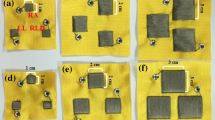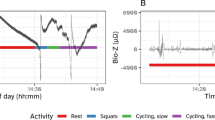Abstract
This study assesses the accuracy of heart rate detection using custom fit intelligent garments with integrated textile electrodes. Two single lead electrocardiograms (ECGs) where recorded from 5 subjects using wet Ag/AgCl (WE) and textile electrodes (TE). During recording the subjects were asked to perform several tasks. Offline, the ECGs recorded from the WE were examined and the number of R wave peaks for each subject where counted by a human observer. This count served as the gold standard. A computer program was used to detect R peaks from both the WE and TE. Sensitivity of each system was determined by comparing computer program based heart rates from WE and TE to the gold standard. The system with TE obtained a mean sensitivity of 76.47%. This was significantly lower than with WE (mean: 98.19%). Results indicated that the custom skin layers did not perform accurately whilst performing tasks involving movement of the trunk and limbs.
Access this chapter
Tax calculation will be finalised at checkout
Purchases are for personal use only
Preview
Unable to display preview. Download preview PDF.
Similar content being viewed by others
References
UN Demographic Indicators 1950–2050, medium estimate (June 2011), http://unstats.un.org/socind
Milosevic, M., Shrove, M.T., Jovanov, E.: Applications of Smartphones for Ubiquitous Health Monitoring and Wellbeing Management. Journal of Information Technology and Application (JITA) 1(1), 7–14 (2011)
Kirkland, R.A., Karlin, N.J., Stellino, M.B., Pulos, S.: Basic Psychological Needs Satisfaction, Motivation, and Exercise in Older Adults. Activities, Adaptation & Aging 35(3), 181–196 (2011)
McCann, J.: Design for Ageing Well: Improving the Quality of Life for the Ageing Population Using a Technology Enabled Garment System. Advances in Science and Technology 60, 154–163 (2009)
Luprano, J., Sola, J., Dasen, S., Koller, J.M., Chetelat, O.: Combination of body sensor networks and on-body signal processing algorithms: The practical case of MyHeart project. In: Proc. Int. Workshop Wearable Implantable Body Sens., pp. 76–79 (2006)
Xu, P., Zhang, H.: Textile-structured electrodes for electrocardiogram. Textile Progress 40, 183–213 (2008)
Cho, H.S., Koo, S.M., Lee, J., et al.: Heart Monitoring Garments Using Textile Electrodes for Healthcare Applications. J. Med. Syst. 35, 189–201 (2009)
McAdams, E.: Wearable Sensor Systems: The Challenges. In: 33rd Annual International Conference of the IEEE EMBS, Boston, Massachusetts USA, August 30-September 3, pp. 3648–3651 (2011)
Lerch, T., MacGillivray, M., Domina, T.: 3-D laser scanning: A model of multidisciplinary research. Journal of Textiles and Apparel Technology and Management 5, 1–22 (2007)
Bougourd, J., McCann, J., Stevens, K.: Design for Ageing Well: Product that is Fit for Purpose Driven by User Engagement. In: Include 2011 The Role of Inclusive Design in Making Social Innovation Happen, April 18-20 (2011)
WHO. "Obesity: preventing and managing the global epidemic. Report of a WHO Consultation," WHO Technical Report Series 894. World Health Organization, Geneva (2000)
Bougourd, J., McCann, J., Stevens, K.: Communicating the Benefits of Smart Textiles for Functional Clothing through User-Centred Design. In: Proceedings from the Textile Institute World Conference, vol. 3(2) (2010)
Mattmann, C., Amft, O., Harms, H., Tröster, G., Clemens, F.: Recognizing upper body postures using textile strain sensors. In: Proc. of the 11th IEEE International Symposium on Wearable Computers, ISWC (2007)
Pan, J., Tompkins, W.J.: A real-time QRS detection algorithm. IEEE Trans. Biomed. Eng. 32, 230–236 (1985)
Bland, J.M., Altman, D.G.: Statistical methods for assessing agreement between two methods of clinical measurements. Lancet 1, 307–310 (1986)
Author information
Authors and Affiliations
Editor information
Editors and Affiliations
Rights and permissions
Copyright information
© 2012 Springer-Verlag Berlin Heidelberg
About this paper
Cite this paper
Cleland, I., Nugent, C., Finlay, D., Burns, W., Bougourd, J., Armitage, R. (2012). Assessment of Custom Fitted Heart Rate Sensing Garments whilst undertaking Everyday Activities. In: Donnelly, M., Paggetti, C., Nugent, C., Mokhtari, M. (eds) Impact Analysis of Solutions for Chronic Disease Prevention and Management. ICOST 2012. Lecture Notes in Computer Science, vol 7251. Springer, Berlin, Heidelberg. https://doi.org/10.1007/978-3-642-30779-9_16
Download citation
DOI: https://doi.org/10.1007/978-3-642-30779-9_16
Publisher Name: Springer, Berlin, Heidelberg
Print ISBN: 978-3-642-30778-2
Online ISBN: 978-3-642-30779-9
eBook Packages: Computer ScienceComputer Science (R0)




